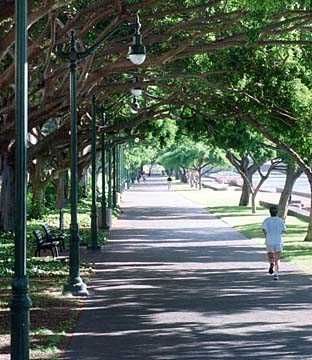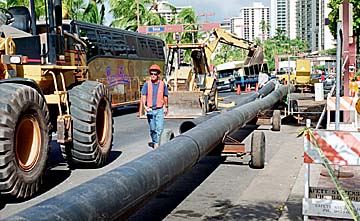


Waikiki’s
lookin’ better
From building a new home for
What's new
the zoo's Komodo dragons to installing
new street lights to renovating the
Natatorium, the city is busy with
construction projects this holiday seasonBy Gordon Y.K. Pang
Star-BulletinConcrete barriers and orange netting block crosswalks. Streets are ripped up. Police officers are at intersections directing traffic.
It's not what visitors seeking to escape dreary winters expect.
But it's what they are encountering as a multitude of city construction projects continue in Waikiki this holiday season -- all part of Mayor Jeremy Harris' plan to spruce up Waikiki.
Projects range from the controversial renovation of the Waikiki War Memorial Natatorium to installation of landscaping and fancier street lights along Ala Wai Boulevard.
"If anything, some tourists are confused (by the construction)," said Nalani Kapalu, the desk captain for Palekaiko Beachboys on Kuhio Beach.

When they see construction activity on the beach next to the Moana Hotel, some are worried that a new hotel is going up. They are relieved to hear that is not the case, she said."I tell them, 'When you come back, it's going to look better,'" Kapalu said.
Don and Joan Hinrichs of Osakis, Minn., were almost oblivious to the activity as they sat on a bench fronting Kuhio Beach to admire the ocean.
"It doesn't interfere with anything we're doing," said Don Hinrichs, a first-time Hawaii visitor. "It's just a fact of life."
City officials say the projects are critical.
"A vigorous visitor industry is vital to Oahu's economic recovery," said Councilman Duke Bainum, who represents the Waikiki area.
Added Harris, "Unless we revitalize Waikiki, both the public and private facilities, we're not going to continue to get return visitors."

Rick Egged, president of the Waikiki Improvement Association, agreed. "You've got to go in there and tear up the streets before you can make things work."That kind of thinking also seemed to make sense to Harold Pingel of St. Louis, Mo., who was visiting Hawaii for the fifth time.
"It would be nice if this was happening while we weren't here, but if it needs to be done ..." Pingel said. "You've got to keep things going, keep those revenues dollars moving."
Some of the projects are out of necessity -- either to replace or expand public works equipment. For instance, a $4.5 million waste-water force main is going up for the Public Baths near Kapahulu Avenue. The beach-walk sewer pumping station is also due to be replaced, at a cost of $25 million, beginning in July 2002.
The Board of Water Supply, meanwhile, is putting in a $2 million, 16-inch waterline tunneling below much of Waikiki. That work is expected to run through at least 2001.

Other projects are designed primarily to make Waikiki more friendly to foot traffic.Aloha kiosks with volunteers are designed to make pedestrians feel safer, while the sides of the Ala Wai from Kapahulu Avenue to Ala Moana Boulevard have had a face lift with foliage and new street lights.
The $11.8 million Kuhio Beach expansion project -- which includes a widened beach and sidewalk, a new police substation, restrooms and concession stand -- is the centerpiece.
It also remains a contentious issue even after years of debate. Some have questioned the need to put any structures on the beach, preferring to see the substation further inland.
Managing Director Ben Lee said that restrooms are required on one of the busiest Oahu beaches and that a police station has deterred nighttime crime.

The restrooms will be done by March 1, and the substation soon after, Lee said.The expanded beach and sidewalk make it more accommodating to visitors, he said. "The concept is to bring Kapiolani Park's ambience into Kuhio Beach."
But the beach expansion will mean taking away a lane of Kalakaua Avenue, a prospect that has riled Dale Evans, president of Charley's Taxi and Limousine.
Drivers have already reported taking five minutes -- double the usual time -- to get from Kaiulani Avenue to Kapahulu Avenue as a result of lane closures along Kalakaua, Evans said.
He believes a bottleneck at the Diamond Head end will cause a backup at the Ala Moana Boulevard side.
Lee pointed to a city study that showed the loss of a lane having a minimal traffic impact.

Paul Tong, general manager of the Hyatt Regency Waikiki, said the city has done what it can to minimize the problem. "Traffic is a little bit tight here and there, but they have cops down there the whole time," Tong said. "They always seem to be able to avoid the crunch."Locals who work and play on and around the beach have mixed feelings about the construction.
Entertainer Cerdan Abellira, who has hung out on the beach much of his 43 years, thinks they're unnecessary.
"I think Jeremy Harris just wants to act like he's doing something good," Abellira said.
Beach improvements made five years ago to spruce up the area were satisfactory, he said.
Larry Akiyama, a Waikiki beachboy for 30 years, said the beach will be nicer when it's all done, but added, "They do this every time around election time."
Sam Bren, chairman of the Waikiki Neighborhood Board, said he appreciates that many of the projects are going on simultaneously. "The faster it is accomplished, the better Waikiki is going to be for it."

Area leaders are already talking about the next projects.The Waikiki Improvement Association's Egged said it's critical to begin upgrading Kuhio Avenue.
Now, he said, "it looks a lot like Kalakaua did in the late '80's: The sidewalks are too narrow and uneven, and there's not enough landscaping."
Harris, Bainum and other city leaders, meanwhile, are anticipating the analysis for a plan to send the city's pending CityTram into Waikiki, reducing the number of city buses flowing into the area.
"The lacking element is an efficient and integrated transportation system," Bainum said.
That would include not only a Honolulu-wide tram, but an internal circulator tram, peripheral parking and possibly a new bridge over the Ala Wai Canal, he said.

Projects the city is undertaking in Waikiki: What's new
1: Kuhio Beach / Kalakaua promenade
Description: Relocate police substation, restrooms, concession stand; expand beach and sidewalk.
Cost: $11.8 million
Completion: Summer 2000, with substation and restrooms completed by spring
2: Ala Wai Blvd. street lights
Description: New historic and decorative lamps and posts to complement those put on the mauka side of the street last year.
Cost: $450,000
Completion: Done
3: Honolulu Zoo
Description: New facilities for the Komodo dragon, gharials and elephants.
Cost: $7.8 million ($4.5 million for the elephants)
Completion: Dragon facility done, gharial exhibit by summer 2000, elephants by sometime in 2002
4: Natatorium renovation
Description: Renovation of facade, bleachers, restrooms and other exterior parts of the Waikiki War Memorial Natatorium. Litigation has hung up the pool portion.
Cost: $4 million (originally $11.5 million with pool)
Completion: February 2000
5: Kapiolani Park Bandstand
Description: Replacing the old bandstand and sprucing up the surrounding area.
Cost: $3 million
Completion: May 2000
6: Kapiolani Park street lights
Description: New security lighting system for Kapiolani Park from the fountain to Paki Avenue.
Cost: $900,000
Completion: Kalakaua portion completed, Paki Avenue portion June 2000
7: Mini parks and bus shelters
Description: Four mini parks on vacant lots as well as new bus shelters along Kuhio Avenue.
Cost: $700,000
Completion: Done
8: Historic trail markers
Description: Continuing installation of 21 historic trail markers from the Convention Center through Kapiolani Park.
Cost: estimated $210,000
Completion: Four done this year, four next year
9: Security cameras
Description: Six security cameras along Kalakaua Avenue from Royal Hawaiian Avenue to Paokalani Avenue.
Cost: $120,000
Completion: Done
10: Aloha kiosks
Description: Small information/security stations, similar to the kobans of Japan, to be staffed by volunteers.
Cost: $10,000 (with help from merchants)
Completion: Two done, two next year
11: Kalakaua Ave. street lights, part 1
Description: New historic and decorative lamps and posts from Ala Wai Boulevard to Ala Moana Boulevard.
Cost: $550,000
Completion: Done
12: Ala Wai promenade, parts I, II and III
Description: Continuing the Landscaping and repaving on the mauka side of the Ala Wai Canal.
Cost: $4.1 million
Completion: September 2000
13: Publication racks
Description: New, more sightly paid and unpaid publications racks at 72 locations throughout Waikiki.
Cost: $432,000
Completion: Unknown
14: Ala Wai Blvd. landscaping
Description: Sprucing up the mauka (canal side) sidewalk with help from the Hawaii Hotel Association and others.
Cost: Not applicable (done by outside agency)
Completion: Done
15: Public Baths Wastewater Force Main
Description: Sewer line from the Honolulu Zoo to Ahua Street.
Cost: $4.5 million
Completion: February 2000
16: Kalakaua Ave. street lights, part 2
Description: New historic and decorative lamps and posts from Pau Street to Kapahulu.
Cost: $3.5 million
Completion: May 2000
17: Replace / add 100 ironwood trees
Description: Replacement and addition of 100 ironwood trees along Kalakaua from Kapahulu Avenue to Paki Avenue.
Cost: Not applicable (done in-house)
Completion: Early 2000